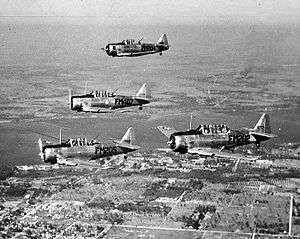75th Flying Training Wing (U.S. Army Air Forces)
| 75th Flying Training Wing | |
|---|---|
|
Vultee BT-13s from Buckingham AAF flying in formation. BT-13s were used as target towing aircraft for flexible gunnery training. | |
| Active | 1943-1946 |
| Country | United States |
| Branch | United States Army Air Forces |
| Type | Command and Control |
| Role | Training |
| Part of | Army Air Forces Training Command |
| Engagements |
|
The 75th Flying Training Wing was a flying training wing of the United States Army Air Forces. At the time, a wing controlled several multi-squadron groups. It was last assigned to the Army Air Forces Flying Training Command, and was disbanded on 15 June 1946 at Buckingham Army Airfield, Florida.
There is no lineage between the United States Air Force 75th Air Base Wing, established on 5 February 1942 as the 75th Observation Group at Ellington Field, Texas and this organization.
History
The wing was a World War II Command and Control organization, initially part of Eastern Flying Training Command. The mission of the wing was to train aerial gunners. Fixed gunnery training for air cadet pilots was carried out at Eglin Army Airfield, while flexible gunnery training for enlisted gunners was carried out both at Tyndall Army Airfield in northern Florida and Buckingham Army Airfield in Southwest Florida. As the men graduated from flexible gunnery school, they were assigned to combat crews either forming in the United States or as replacements to overseas combat units.[1]
As training requirements changed during the war, schools were activated and inactivated or transferred to meet those requirements.[1]
Lineage
- Established as 75th Flying Training Wing, on 14 August 1943
- Activated on 25 August 1943
- Disbanded on 16 June 1946.[2]
Assignments
- Army Air Forces Eastern Flying Training Command, 25 August 1943
- AAF Western Flying Training Command, 15 December 1945 – 16 June 1946 [2]
Training aircraft
The schools of the wing flew two types of aircraft. Gunnery trainers and gunnery targets.
- The trainers used for fixed gunnery training for pilots was the North American AT-6 Texan
- The trainers used for flexible gunnery training for aerial gunners were the AT-18 Hudson and non-combat rated B-24 Liberators.
- Aerial gunnery target two planes were Vultee BT-13s
- Non-combat rated P-40s, P-39s and P-63s, modified for aerial targets were also used.
Assigned Pilot Schools
|
|
Stations
- Buckingham Army Airfield, Florida, 25 August 1943 – 16 June 1946[2]
References
| Wikimedia Commons has media related to 75th Flying Training Wing (World War II). |
![]() This article incorporates public domain material from the Air Force Historical Research Agency website http://www.afhra.af.mil/.
This article incorporates public domain material from the Air Force Historical Research Agency website http://www.afhra.af.mil/.
- 1 2 Manning, Thomas A. (2005), History of Air Education and Training Command, 1942–2002. Office of History and Research, Headquarters, AETC, Randolph AFB, Texas ASIN: B000NYX3PC
- 1 2 3 75th Flying Training Wing, lineage and history document Air Force Historical Agency, Maxwell AFB, Alabama
- ↑ www.accident-report.com: Apalachicola Army Airfield
- ↑ www.accident-report.com: Buckingham Army Airfield
- ↑ www.accident-report.com: Eglin Army Airfield
- ↑ www.accident-report.com: Naples Army Airfiel
- ↑ www.accident-report.com: Tyndall Army Airfield

